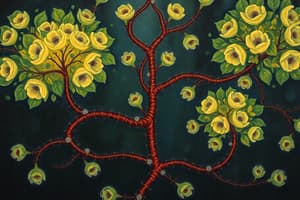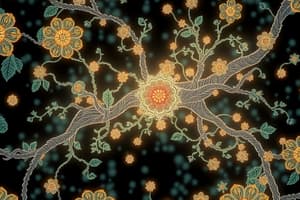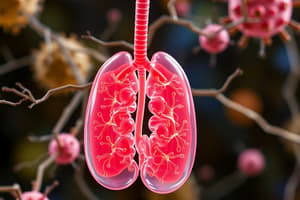Podcast
Questions and Answers
Which of the following is the MOST accurate summary of the role of ATP in cells?
Which of the following is the MOST accurate summary of the role of ATP in cells?
- ATP functions as an enzyme to catalyze metabolic reactions.
- ATP is the primary molecule for long-term energy storage.
- ATP serves as an energy carrier molecule to power cellular activities. (correct)
- ATP acts as a structural component of cell membranes.
During aerobic cellular respiration, how many ATP molecules are directly produced for each glucose molecule?
During aerobic cellular respiration, how many ATP molecules are directly produced for each glucose molecule?
- 4
- 36
- 34
- 2 (correct)
What is the correct, balanced chemical equation for aerobic cellular respiration?
What is the correct, balanced chemical equation for aerobic cellular respiration?
- $C_6H_{12}O_6 + 6O_2 → 6CO_2 + 6H_2O + Energy$ (correct)
- $C_6H_{12}O_6 + 6CO_2 → 6O_2 + 6H_2O + Energy$
- $6CO_2 + 6H_2O → C_6H_{12}O_6 + 6O_2 + Energy$
- $6O_2 + 6H_2O → C_6H_{12}O_6 + 6CO_2 + Energy$
What role do coenzymes such as $NAD^+$ and $FAD$ play in aerobic cellular respiration?
What role do coenzymes such as $NAD^+$ and $FAD$ play in aerobic cellular respiration?
What chemical forms do coenzymes $NAD^+$ and $FAD$ take when they gain hydrogen and electrons?
What chemical forms do coenzymes $NAD^+$ and $FAD$ take when they gain hydrogen and electrons?
Which of the following is NOT a major step in aerobic cellular respiration?
Which of the following is NOT a major step in aerobic cellular respiration?
In eukaryotic cells, where does glycolysis occur?
In eukaryotic cells, where does glycolysis occur?
What is the primary outcome of glycolysis?
What is the primary outcome of glycolysis?
Considering the reactants and products of glycolysis, what are the NET products resulting from the processing of ONE molecule of glucose?
Considering the reactants and products of glycolysis, what are the NET products resulting from the processing of ONE molecule of glucose?
Where does pyruvate oxidation take place in eukaryotic cells?
Where does pyruvate oxidation take place in eukaryotic cells?
What does pyruvate become during pyruvate oxidation?
What does pyruvate become during pyruvate oxidation?
What happens to the carbon dioxide ($CO_2$) produced during pyruvate oxidation?
What happens to the carbon dioxide ($CO_2$) produced during pyruvate oxidation?
For each glucose molecule that enters cellular respiration, how many times does the Krebs cycle occur?
For each glucose molecule that enters cellular respiration, how many times does the Krebs cycle occur?
What are the products generated during the Krebs cycle?
What are the products generated during the Krebs cycle?
In eukaryotic cells, where does the electron transport chain occur?
In eukaryotic cells, where does the electron transport chain occur?
What is the role of molecular oxygen ($O_2$) in the electron transport chain?
What is the role of molecular oxygen ($O_2$) in the electron transport chain?
How does the movement of hydrogen ions ($H^+$) through ATP synthase contribute to ATP production?
How does the movement of hydrogen ions ($H^+$) through ATP synthase contribute to ATP production?
What are the primary end products of the electron transport system?
What are the primary end products of the electron transport system?
Which of the following lists describes the reactants of the electron transport system?
Which of the following lists describes the reactants of the electron transport system?
In what way is fermentation SIMILAR to aerobic respiration?
In what way is fermentation SIMILAR to aerobic respiration?
Flashcards
Aerobic cellular respiration products
Aerobic cellular respiration products
Carbon dioxide, water, and ATP are the products.
How ATP functions
How ATP functions
Energy carrier molecules power cell activities like active transport and muscle contractions.
Molecules of ATP needed
Molecules of ATP needed
34 ATP molecules.
ATP produced per glucose
ATP produced per glucose
Signup and view all the flashcards
Aerobic respiration equation
Aerobic respiration equation
Signup and view all the flashcards
Coenzymes in Aerobic Cellular Respiration
Coenzymes in Aerobic Cellular Respiration
Signup and view all the flashcards
What coenzymes become
What coenzymes become
Signup and view all the flashcards
Four Major Steps of Aerobic Cellular Respiration
Four Major Steps of Aerobic Cellular Respiration
Signup and view all the flashcards
Where glycolysis occurs
Where glycolysis occurs
Signup and view all the flashcards
What happens to glucose in Glycolysis?
What happens to glucose in Glycolysis?
Signup and view all the flashcards
Glycolysis Reactants
Glycolysis Reactants
Signup and view all the flashcards
Glycolysis Products
Glycolysis Products
Signup and view all the flashcards
Where Pyruvate Oxidation occurs
Where Pyruvate Oxidation occurs
Signup and view all the flashcards
Pyruvate outcome
Pyruvate outcome
Signup and view all the flashcards
What happens to CO₂
What happens to CO₂
Signup and view all the flashcards
How many times the Krebs Cycle occurs
How many times the Krebs Cycle occurs
Signup and view all the flashcards
Electron Transport System Products
Electron Transport System Products
Signup and view all the flashcards
Electron Transport System Reactants
Electron Transport System Reactants
Signup and view all the flashcards
How Fermentation Differs
How Fermentation Differs
Signup and view all the flashcards
How Fermentation Resembles
How Fermentation Resembles
Signup and view all the flashcards
Study Notes
- Carbon dioxide, water, and ATP are products of aerobic cellular respiration.
- ATP is used as an energy carrier molecule for powering cell activities.
- Cells use ATP to facilitate tasks like active transport and muscle contractions.
- 34 molecules of ATP are required.
- Aerobic cellular respiration produces about 2 ATP molecules for each glucose molecule.
- The chemical equation for aerobic cellular respiration is: Glucose + Oxygen -> Carbon Dioxide + Water + ATP
Coenzymes in Aerobic Cellular Respiration
- NAD+ (nicotinamide adenine dinucleotide) and FAD (flavin adenine dinucleotide) are coenzymes used in Aerobic Cellular Respiration.
- Coenzymes act as electron carriers, accepting and transferring hydrogen atoms through glycolysis and the Krebs cycle
- When coenzymes gain hydrogen and electrons they become NADH and FADH2
The 4 Major Steps of Aerobic Cellular Respiration
- Glycolysis is the first step.
- Pyruvate Oxidation is the second step.
- The Krebs Cycle is the third step.
- The Electron Transport Chain is the fourth step.
Step 1: Glycolysis
- Glycolysis occurs in the cytosol of cells.
- Glucose molecules are broken down during glycolysis.
- Reactants: 1 molecule of glucose, 2 ATP, and NADH
- Products: 2 Pyruvate, 2 ATP, and 2 NADH
Step 2: Pyruvate Oxidation
- Occurs in the mitochondrial matrix in eukaryotic cells.
- Pyruvate is converted into Acetyl CoA.
- Carbon dioxide is released as waste and diffuses out of the cell.
- The pyruvate oxidation reactants for each glucose molecule include 2 molecules of pyruvate, 2 molecules of NAD+, and 2 molecules of coenzyme.
- The pyruvate oxidation products are 2 molecules of acetyl-CoA, 2 molecules of carbon dioxide, and 2 molecules of NADH.
Step 3: The Krebs Cycle
- A two-carbon unit of acetyl-CoA is combined with a four-carbon molecule (oxaloacetate) to form a six-carbon citrate at the cycle's start.
- Carbon dioxide, NADH, FADH2, and one molecule of ATP are produced.
- The cycle runs twice for every glucose molecule.
- Reactants for each glucose molecule: 2 molecules of acetyl CoA.
- The products are: 4 carbon dioxide, 2 ATP, 6 NADH and 2 FADH2.
Review of Glycolysis, Pyruvate Oxidation, and the Krebs Cycle
- Glycolysis occurs in the cytoplasm, produces 2 ATP per glucose molecule, and 2 NADH.
- Pyruvate Oxidation happens in the mitochondrial matrix, producing 2 NADH
- The Krebs Cycle happens in the mitochondrial matrix, producing 2 ATP, 6 NADH, and 2 FADH2
Step 4: Electron Transport Chain
- The electron transport chain occurs within the inner membrane of mitochondria in eukaryotic cells.
- NADH and FADH2 donate their electrons to the electron transport chain, producing ATP.
- Molecular oxygen acts as the final electron acceptor.
- Oxygen combines with hydrogens to form water
- As hydrogen moves through ATP synthase, it moves down its concentration gradient and converts ADP to ATP.
- NADH, FADH2, and oxygen are the electron transport system reactants.
- NAD+, FAD, water and ATP are the electron transport system products.
- Glycolysis is the first process in breaking down glucose.
- Pyruvate oxidation, the Krebs cycle, and the electron transport chain occur in the mitochondria.
- Pyruvate oxidation transforms pyruvates into acetyl and carbon dioxide.
- The Krebs cycle produces both NADH and FADH2.
- The electron transport system requires oxygen and turns it into water.
- Carbon dioxide is produced from breaking down food molecules in aerobic cellular respiration.
- Oxygen does not turn into carbon dioxide.
Fermentation
- Fermentation lets glycolysis produce small amounts of ATP without oxygen.
- Fermentation and aerobic respiration both produce energy (ATP) from glucose breakdown
- Fermentation produces two ATP molecules.
- Alcohol and lactate fermentation are types of fermentation
- Beer is made with alcohol fermentation, while yogurt is made with lactate fermentation.
Studying That Suits You
Use AI to generate personalized quizzes and flashcards to suit your learning preferences.




